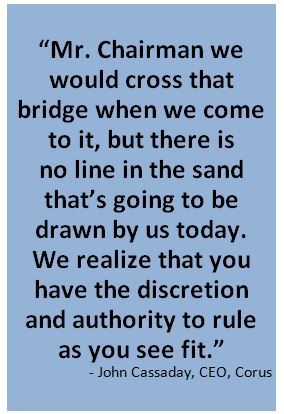
GATINEAU – Corus Entertainment was on the hot seat today, defending its proposed $400 million purchase of specialty services Teletoon, Historia and Series+ in front of the CRTC. The company is buying the assets from Bell Media as part of the latter’s requirement to divest assets resulting from its purchase of Astral.
“We are here today to convince you that we are not only the best possible home for these assets but that our acquisition of these services is in the public interest. Allowing Corus to continue to grow will translate into more spending on Canadian programming and healthy competition in Quebec,” John Cassaday, president and CEO of Corus, said during his opening remarks.
It didn’t take long for the commissioners to delve into Corus’s ownership and its potential impact on the transaction. CRTC chair Jean-Pierre Blais wondered why the Corus-Shaw Communications relationship (JR Shaw owns control of both companies) should be treated as a single entity when it comes to ownership, but separately as it relates to diversity of voices, group-based licensing and vertical integration.
Cassaday acknowledged that the two companies are affiliated, noting that “by virtue of this relationship, we end up walking on both sides of the street on a frequent basis.” But he adds the two firms are structurally separate and make their own decisions based on what’s best for each firm.
The Corus chief executive extended his answer to the issue of tangible benefits regarding the acquisition of Historia and Series+. “When JR Shaw acquired these assets from Canwest, he already paid benefits on them and in fact when we acquired the Historia and Series+ shares, we didn’t trigger a change of control,” Cassaday explained. “That change of control was only triggered when we acquired the shares from Bell, so we feel in this particular instance… that there is clarity at least as it relates to this issue.”
Blais raised the spectre of approving the acquisition with the condition that Corus divest some assets and after not receiving the answer he was looking for, he flatly asked if Corus would walk away from the transaction if it was forced to divest assets. “Mr. Chairman we would cross that bridge when we come to it, but there is no line in the sand that’s going to be drawn by us today. We realize that you have the discretion and authority to rule as you see fit,” Cassaday said in response to the question.
CRTC vice-chair of broadcasting Tom Pentefountas chimed in a little later in the morning asking Corus to explain the added value it brings as part of the transaction.
Cassaday noted that this isn’t the case of a derelict asset being picked up, but rather the purchase of “crown jewels” that the Commission has forced Bell to sell. “So the real benefit is going to be from our secret sauce which is growing businesses and continuing to increase revenue which translates into incremental spending for Canadian programming,“ he said. “Then of course the huge benefit that’s on the table is the public benefits monies of which 75% is going to go on the screen.”
A number of interveners took centre stage in the afternoon to raise additional questions about the proposed transaction. The Canadian Cable Systems Alliance (CCSA) and Telus Communications argued that vertical integration provisions need to be imposed on Corus as a result of its affiliation with Shaw.
The CCSA expressed concerns that the concentration of additional programming services with Corus will have negative consequences on its members‘ ability to secure programming rights on fair and reasonable terms. Chris Edwards, VP of regulatory with the CCSA, discounted suggestions from Corus that their case is different than Bell’s in terms of negotiating power and anti-competitive behaviour.
“It really comes down to [being able] to secure the rights for distribution for both the linear product and the broadband product that are fair and reasonable. And on that question, there’s really nothing to distinguish the two cases in terms of the balance of power,” he said.

Harris Boyd, president of Solaracom and who consults for the CCSA, noted that the potential for anti-competitive behaviour is clearly apparent because Shaw is the largest cable company, the second largest satellite competitor, a big telephone and Internet company as well as being CCSA members’ largest wholesale content distributor. “So the potential is there for them to use their force,” he argued. “They will own over 40 specialty and pay services with this transaction and they could use that against other distributors.”
The Canadian Media Production Association (CMPA) said the proposed acquisition of Teletoon by Corus should raise red flags. Michael Hennessy, president and CEO of the CMPA, noted that if approved Corus would control a significant majority of the children’s and animation programming services market. “If this application is approved, the competitive children’s programming market that we had in Canada will be replaced with a near-Corus-monopoly,” he said, adding Corus would control 70% of the English-language children’s television audience and 85% of Canadian English-language animation programs.
Despite its concerns, the CMPA supports the acquisition with some caveats. Such a transaction that would give so much control over children’s and animation program to one company requires conditions of licence (COLs) to mitigate against the negative impact on programming diversity. Some of the COLs are: the exclusion of Teletoon and Teletoon Retro from the group-based licensing regime; require 75% of expenditures on first run Canadian programs and 75% of all programs be sourced from independent producers.
Without the recommended safeguards, CMPA’s support for the transaction would disappear. “We cannot see how approval of this application could possibly be in the public interest. It would be BCE-Astral #1 all over again,” argued Hennessy.
The hearing continues on Wednesday with additional interveners and the reply from Corus.



